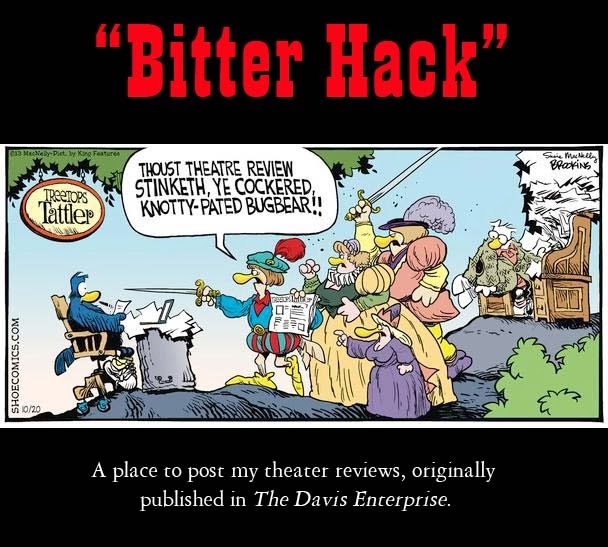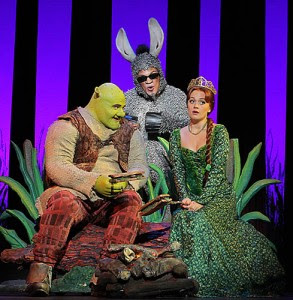 I have a guilty secret. A critic reviews many Christmas-themed shows at this time of year, but I have to admit that my favorite is “Every Christmas Story Ever Told (and then some),” the holiday offering at Capital Stage again this year.
I have a guilty secret. A critic reviews many Christmas-themed shows at this time of year, but I have to admit that my favorite is “Every Christmas Story Ever Told (and then some),” the holiday offering at Capital Stage again this year.I first saw this show — written by Michael Carleton, Jim Fitzgerald and Gary Alvarez, and directed this year by Jonathan Williams — in 2004 and thought it hilarious then. The appeal has not diminished over the years.
While this is an intelligent, funny show in its own right, what makes it work is the strong cast of three, who must each sweat off a few pounds during every performance.
Eric Wheeler, as Eric, is determined to present a straight version of “A Christmas Carol” but runs into opposition from his two partners, Peter Mohrmann and Gary Martinez, who are tired of repeating the Dickens story every year and want to pay tribute to all those other BHCs (Beloved Holiday Classics) of screen, TV and print. Eric agrees, just as long as “A Christmas Carol” is included.
And off they go.
The trio elicits suggestions from the audience for favorite movies, television programs, Christmas foods, traditions, commercials, etc. It doesn’t stop at Christmas, but also gives a nod to Hanukkah (“It bears similarities to other Jewish festivals: They tried to kill us. We survived. Let’s eat!”) and Kwanzaa (“The best part of Kwanzaa is that you’ll never see a special called ‘A Very Brady Kwanzaa.’ “)
But the meat of the show is the retelling of all the stories we all know so well.
Wheeler is reluctantly dragged into the project when he is dressed as The Grinch for a very funny send-up of “How the Grinch Stole Christmas.” Later, he will shine in such roles as Hermie, the elf who wants to be a dentist from “Rudolph the Red Nose Reindeer” (hilariously renamed, for copyright reasons) and makes a fabulous Scotsman.
A wonderful impersonator, Wheeler’s Scrooge (so perfect in voice and body language as The Simpsons’ Mr. Smithers), Tim Gunn from “Project Runway,” and Jimmy Stewart from “It’s A Wonderful Life” are spot-on.
Mohrmann as the Ghosts of Past, Present and Future, his wonderful recreation of host Jim Lange on the fruitcake version of “The Dating Game,” his funny Yukon Cornelius from “Rudolph the Red-Nosed Reindeer,” and even his attempt at being supermodel Heidi Klum are all great fun (and he is particularly fetching in his Carmen Miranda headpiece in the opening segments).
Mohrmann also shares with the audience Christmas customs from around the world, such as the story of Holland’s “Sinterklaass,” who arrives on a steamer from Spain with his helper, a twisted dark gnome known as “Black Peter” who punishes bad children. Just to put the “joy” in Christmas, you know.
And each year, I try to find a different way to say how much I love Martinez’s characterizations but keep coming back to the fact that he is the heart of this show. Zaniness abounds throughout, but when Martinez steps into the spotlight as Linus and tells us the true meaning of Christmas, or becomes Cindy-Lou Who asking the Grinch why he is taking her Christmas tree, or talks to George Bailey (from “It’s a Wonderful Life”) as Clarence Goodbody, the angel trying to get his wings, there is no denying that he reminds us what Christmas should be about.
The script for this show is usually updated, this year adding a line about pepper spray, which didn’t get quite the big laugh they’d hoped. (“Too soon?” asks Mohrmann.)
The show is so fast-paced as to leave you breathless, whether from the pace, or from laughing. It’s a wonderful way to see all of your own personal favorite BHCs in one place for one price.
Scenic design this year is by Jonathan Williams, and if I am remembering correctly from previous productions, is not as lavish as before, but with the larger area of the new Cap Stage theater, the cast is able to interact with the audience more, and that is more fun.
Do yourself a favor and treat yourself and your family to this show. It is an absolute delight, whose enjoyment does not diminish with multiple viewings. As you leave the Capital Stage theater, you’ll be ready for the Christmas season and may go about greeting everyone with a cheery “Mata-Ki-Te-Rangi” (“Merry Christmas” in Icelandic).





















